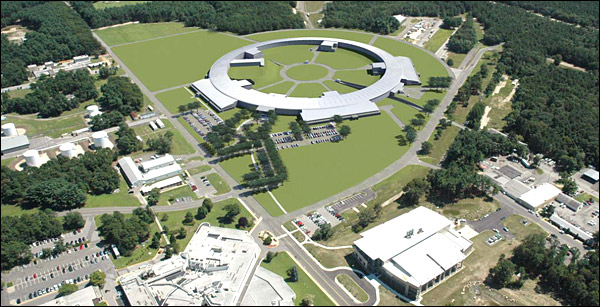Department of Energy Approves Construction Start of NSLS-II Project
January 12, 2009
UPTON, N.Y. -– To advance its science mission that focuses on critical national challenges, the U.S. Department of Energy (DOE) has approved the construction start of the state-of-the-art National Synchrotron Light Source II (NSLS-II) at Brookhaven National Laboratory. The scientific advances resulting from research at the new facility will support technological and economic development in multiple sectors of the economy, from next-generation energy technologies to materials science and biotechnology.
DOE has granted "Critical Decision 3" (CD-3) status to the NSLS-II, approving the start of construction in fiscal year (FY) 2009 and scheduling completion in FY 2015. DOE has approved a total project cost for NSLS-II of $912 million.
 enlarge
enlarge
Rendering of the National Synchrotron Light Source II as it will appear on the Brookhaven campus. In the foreground at left is the current NSLS. The Center for Functional Nanomaterials is at right.
“NSLS-II is the largest capital project under construction at any of the 10 National Laboratories throughout the country that are owned by the Department of Energy’s Office of Science,” said DOE’s Brookhaven Site Office Manager Mike Holland. “This represents a major investment by the Department of Energy in Brookhaven National Laboratory and ensures the scientific vitality of BNL, one of the nation’s premier research laboratories, for at least 25 years into the future.”
When it is completed, NSLS-II will be the world’s leading storage-ring-based synchrotron light source. It will be the first light source that combines nanometer spatial resolution with high brightness, coherence, and beam stability, enabling nanometer-scale characterization of materials, with powerful applications to nanotechnology and biotechnology.
The machine will be the newest member of a suite of advanced light sources and neutron facilities operated by DOE's Office of Science that are used by more than 9,000 researchers annually from all disciplines. The NSLS-II will advance exploration of the scientific challenges faced in developing new materials with advanced properties, enabling their study, particularly at the nanoscale, at a level of detail and precision never before possible.
"NSLS-II will provide the world's finest capabilities for x-ray imaging, with unprecedented spatial and energy resolution and the ability to detect single atoms," said Steven Dierker, Associate Laboratory Director for Light Sources. “It will provide advanced tools for discovery-class science in condensed matter and materials physics, chemistry, and biology – science that ultimately will enhance national and energy security and help drive abundant, safe, and clean energy technologies.”
CD-3 is the fourth of five critical decisions that the project will need to achieve in order to progress through the successively more detailed stages of conceptual design, preliminary design, final design, construction, and then operations. A CD-3 approves the start of construction and signifies that a final design review has been performed, that all environmental and safety criteria have been met, all security concerns addressed and the project is ready to begin construction. CD-3 authorizes the project to commit all the resources necessary to execute the project, within the funds provided. CD-2, approving the facility’s performance baseline, was announced in December 2007, and CD-1, siting the facility at DOE's Brookhaven and approving its cost range, was announced in July 2007.
NSLS-II will replace the existing NSLS, which began operations in 1982. NSLS provides essential scientific tools for 2,300 scientists each year from more than 400 academic, industrial and government institutions.
The NSLS-II is funded by the Department of Energy Office of Science (Office of Basic Energy Sciences).
For more information about the NSLS-II project, visit the website at www.bnl.gov/nsls2.
2009-10890 | INT/EXT | Newsroom









